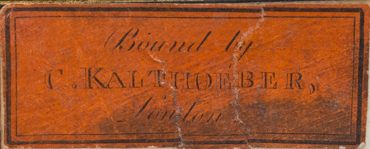THIS PAGE lists additions to the website, including complete books. The books are large so they are presented in parts, as pdf files, making them more manageable for download. Some individual pages are stored as jpg files. The size of the images is around 4800 x 3200 pixels.
14. Links to John Baskerville: Shaping the Alphabet
13. Sallust & Florus, 4to, 1773. Section on the Jugurthine & Catiline Wars added.
12. Link to Baskerville’s type specimen, 1762
11. Virgil, 4to, 1757.
10. Catullus, 4to, 1772, new Carmina
9. Addison, 4to, 1761, Vol 1, Virgil’s 4th Georgic translated by Addison.
8. Additions to Links & contact page.
7. Addison, 4to, 1761, preliminary pages of Volume 1.
6. Terence, 4to, 1772, complete volume.
5. Lucretius, 4to, 1772, complete volume.
4. Juvenal, 4to, 1762, complete volume.
3. Catullus, 4to, 1772, complete volume.
2. Horace, 4to, 1770, complete volume.
1. Title-pages of the books in the list.

This bookbinder’s ticket was pasted into the copy of the works of Virgil, published by Baskerville in 1757, that I photographed for this site. At one period, Christian Kalthoeber, one of several German bookbinders to come to London to supply the growing demand for fine bindings, was the most famous binder in the world, sought after by Catherine the Great of Russia, whose offer he turned down, and a volume of his being brought before George III for the king to see his binding skills. A number of Kalthoeber bindings are in the British Library and many photographs of his work are on the internet.
In his Englische Miscellen, Volume 6, Tübingen, 1801, Johann Christian Hüttner presents a lengthy article in praise of London's bookbinders, a considerable number of whom were Germans who came to England for the opportunities to work brought about by the growing prosperity of so many who could afford to send great numbers of books for binding. The following short extract has been translated by Bettina Reiber:
The famous Kalthöber, who without question is now the foremost bookbinder in the world, recently made a binding which cost thirty guineas (that is 180 Reichstaler). [Baskerville's Virgil, sold in sheets, before binding, was priced at one guinea.] Its beauty resounded immediately, and people kept coming to him for many days to see the masterpiece; lords and ladies were among the visitors, and even the King had heard such an ado about it, that he had the volume brought to Buckingham Palace, kept it with him for five days, and had the most flattering things said to Kalthöber about it.
The sumptuousness of English books can also be seen in the uninterrupted gilding and stamping that takes place in the workshops of the great London bookbinders. The gold is at the ready for the master binders and the first journeymen at all times; the fillet and roll tools are constantly lying on the fire, which is always burning in two grates, winter and summer. In Germany, gilding in the largest workshops is done about two days a week or, at most, a few hours a day.
Luxury, which governs all English wares, has also drawn books into its orbit here. But I fear this cannot be conveyed properly without describing the volumes in the libraries of the King, of Lord Spencer, of the Marquess of Bute, of the Prince of Wales and many hundreds of Peers and Gentlemen. The lengths you go to in England to make an 'editio princeps' of an ancient Greek or Latin author, the washing of the leaves, patching, taking care of the edges, matching the colour of the cover and so forth, all this matters greatly to the English book collectors. But, as previously discussed, what the bookbinder asks for the effort he put into the work is not questioned, always provided that he truly understands his art. For a book lover who is not a sworn Stoic, and who does not exclusively contemplate the pure content of the books, no greater feast can be imagined than the book collection of one of the great Englishmen, e.g. of the Marquess of Lansdowne, or the Dukes of Bedford and Norfolk; the regal library of the vastly rich Duke of Bedford is bound exclusively in red and yellow morocco and heavily gilded; and in the Duke of Norfolk’s equally handsome collection of books not a single volume can be found that is bound in calf leather; everything is in morocco or Russia leather. From this one can envision the appearance of the libraries of the Lords and all the wealthy. In sum, you only have to go through the perfectly ordinary catalogues of the London antiquarian booksellers (which come out around Christmas), or the book and auction catalogues, and notice what magnificent volumes are listed. What in England is called merely 'neat' (or 'nett' in German), is considered a magnificent and expensive binding in Germany, whereas it is mostly the common English binding, which is here called 'calf gilt'. From all this we can easily explain the superiority of the London bookbinder. And yet there are even more reasons.
Namely, 1. the quality of the materials, 2. the distribution of labour, 3. the superior tools, 4. some better handling techniques. [...]
From pages 5-7.